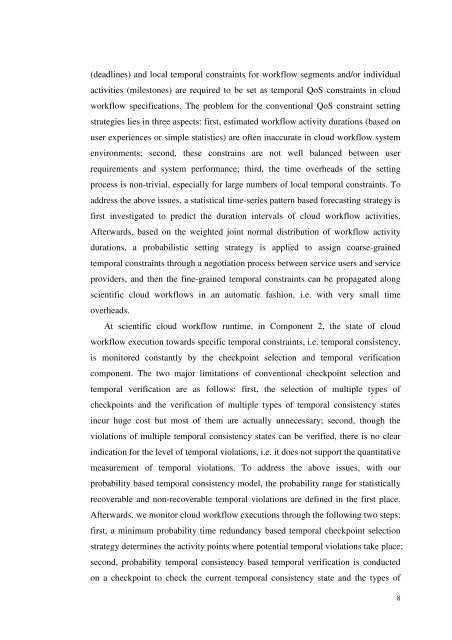Xiao Liu PhD Thesis.pdf - Faculty of Information and Communication ...
Xiao Liu PhD Thesis.pdf - Faculty of Information and Communication ...
Xiao Liu PhD Thesis.pdf - Faculty of Information and Communication ...
Create successful ePaper yourself
Turn your PDF publications into a flip-book with our unique Google optimized e-Paper software.
(deadlines) <strong>and</strong> local temporal constraints for workflow segments <strong>and</strong>/or individual<br />
activities (milestones) are required to be set as temporal QoS constraints in cloud<br />
workflow specifications. The problem for the conventional QoS constraint setting<br />
strategies lies in three aspects: first, estimated workflow activity durations (based on<br />
user experiences or simple statistics) are <strong>of</strong>ten inaccurate in cloud workflow system<br />
environments; second, these constrains are not well balanced between user<br />
requirements <strong>and</strong> system performance; third, the time overheads <strong>of</strong> the setting<br />
process is non-trivial, especially for large numbers <strong>of</strong> local temporal constraints. To<br />
address the above issues, a statistical time-series pattern based forecasting strategy is<br />
first investigated to predict the duration intervals <strong>of</strong> cloud workflow activities.<br />
Afterwards, based on the weighted joint normal distribution <strong>of</strong> workflow activity<br />
durations, a probabilistic setting strategy is applied to assign coarse-grained<br />
temporal constraints through a negotiation process between service users <strong>and</strong> service<br />
providers, <strong>and</strong> then the fine-grained temporal constraints can be propagated along<br />
scientific cloud workflows in an automatic fashion, i.e. with very small time<br />
overheads.<br />
At scientific cloud workflow runtime, in Component 2, the state <strong>of</strong> cloud<br />
workflow execution towards specific temporal constraints, i.e. temporal consistency,<br />
is monitored constantly by the checkpoint selection <strong>and</strong> temporal verification<br />
component. The two major limitations <strong>of</strong> conventional checkpoint selection <strong>and</strong><br />
temporal verification are as follows: first, the selection <strong>of</strong> multiple types <strong>of</strong><br />
checkpoints <strong>and</strong> the verification <strong>of</strong> multiple types <strong>of</strong> temporal consistency states<br />
incur huge cost but most <strong>of</strong> them are actually unnecessary; second, though the<br />
violations <strong>of</strong> multiple temporal consistency states can be verified, there is no clear<br />
indication for the level <strong>of</strong> temporal violations, i.e. it does not support the quantitative<br />
measurement <strong>of</strong> temporal violations. To address the above issues, with our<br />
probability based temporal consistency model, the probability range for statistically<br />
recoverable <strong>and</strong> non-recoverable temporal violations are defined in the first place.<br />
Afterwards, we monitor cloud workflow executions through the following two steps:<br />
first, a minimum probability time redundancy based temporal checkpoint selection<br />
strategy determines the activity points where potential temporal violations take place;<br />
second, probability temporal consistency based temporal verification is conducted<br />
on a checkpoint to check the current temporal consistency state <strong>and</strong> the types <strong>of</strong><br />
8
















